Charles E W Bean, Diaries, AWM38 3DRL 606/254/1 - 1917 - 1933 - Part 12
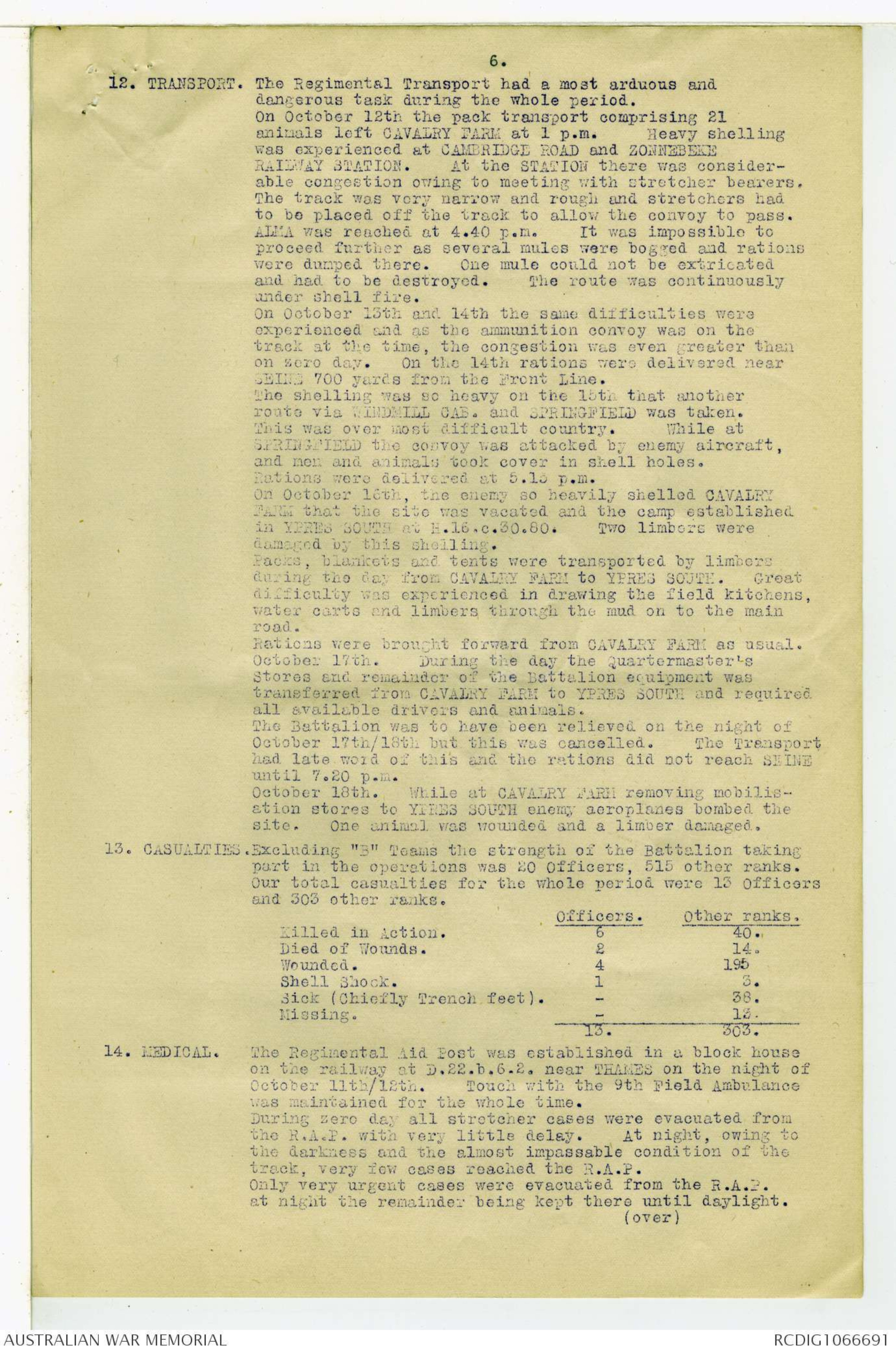

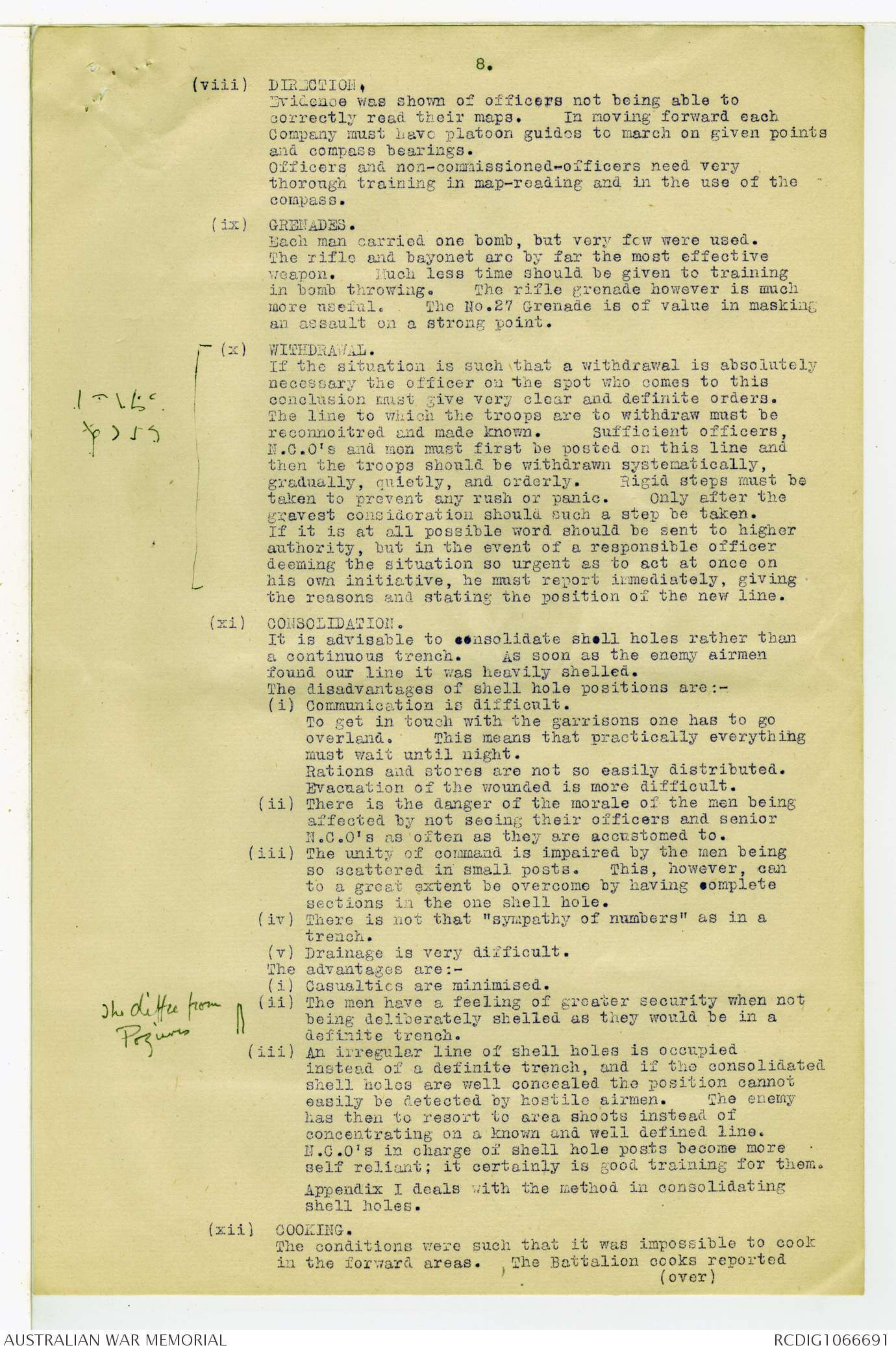

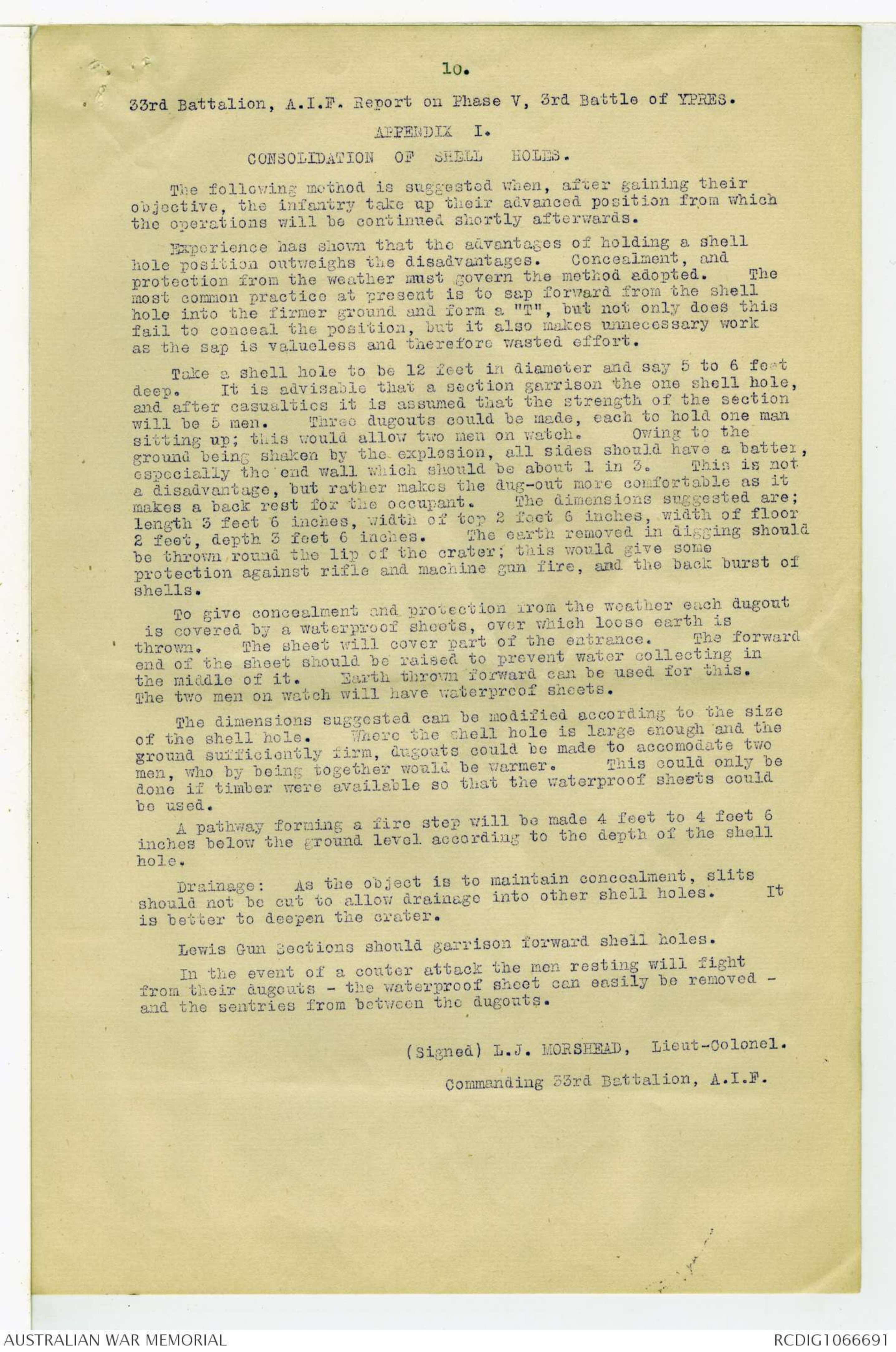
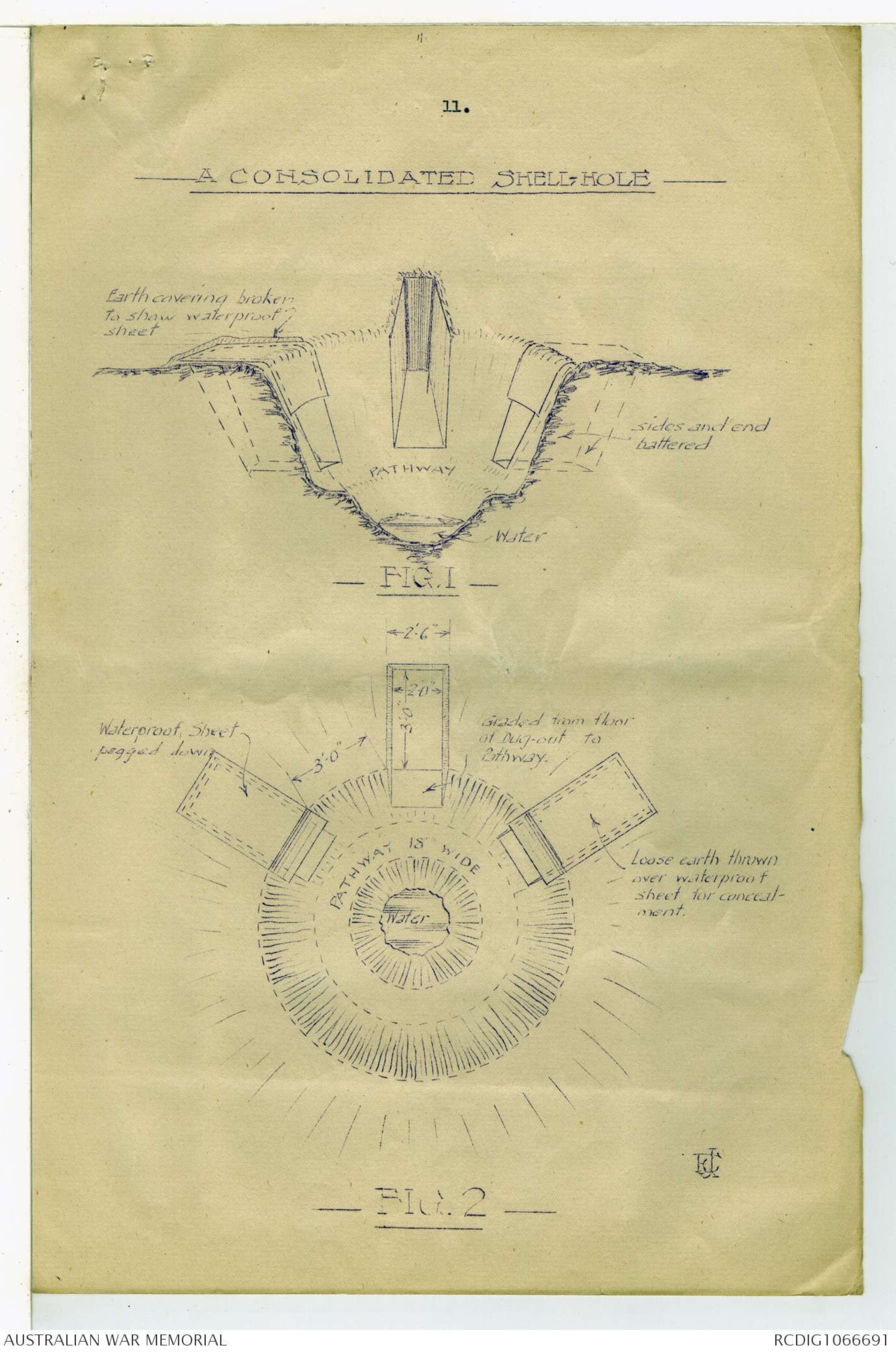
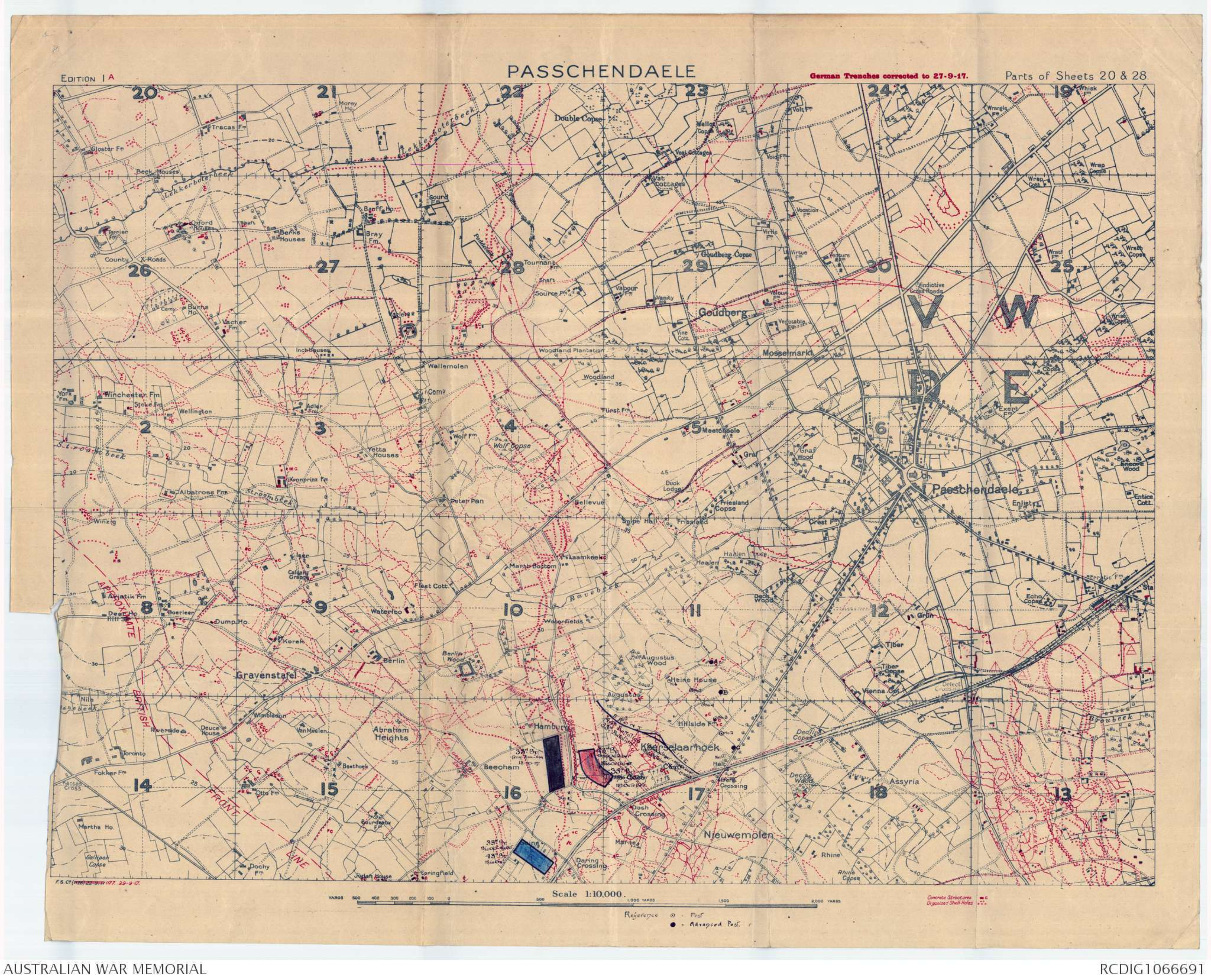
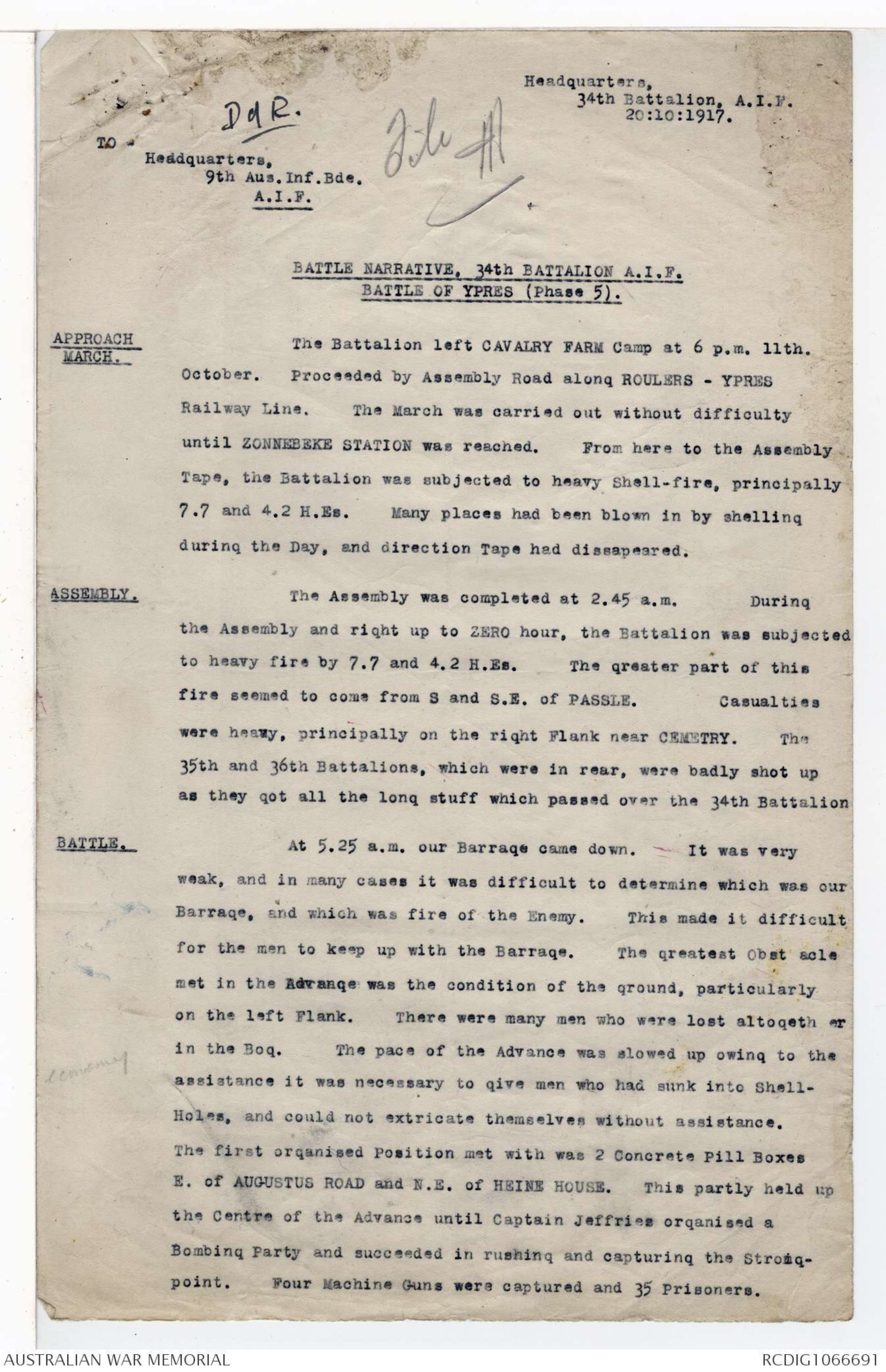
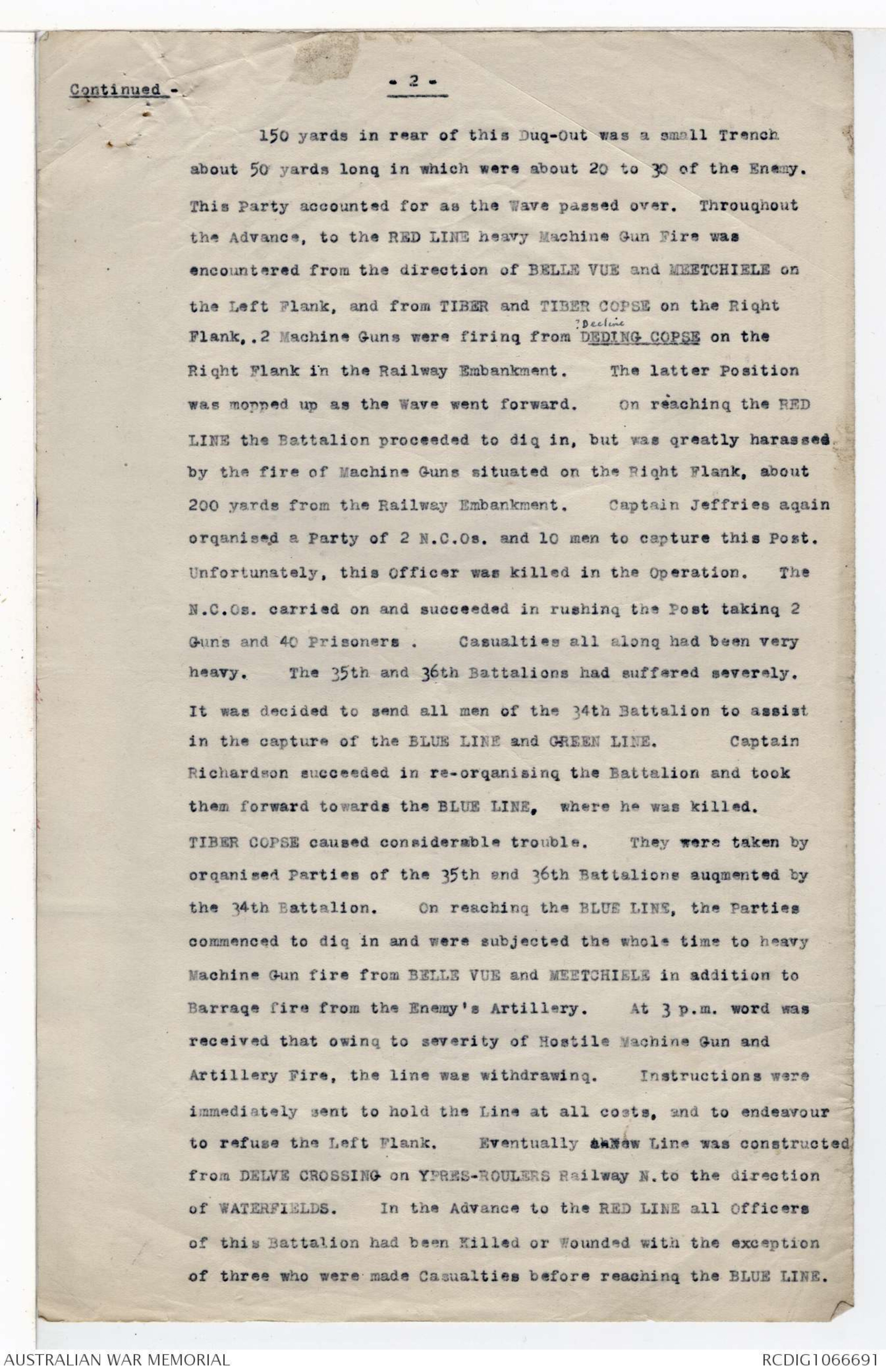
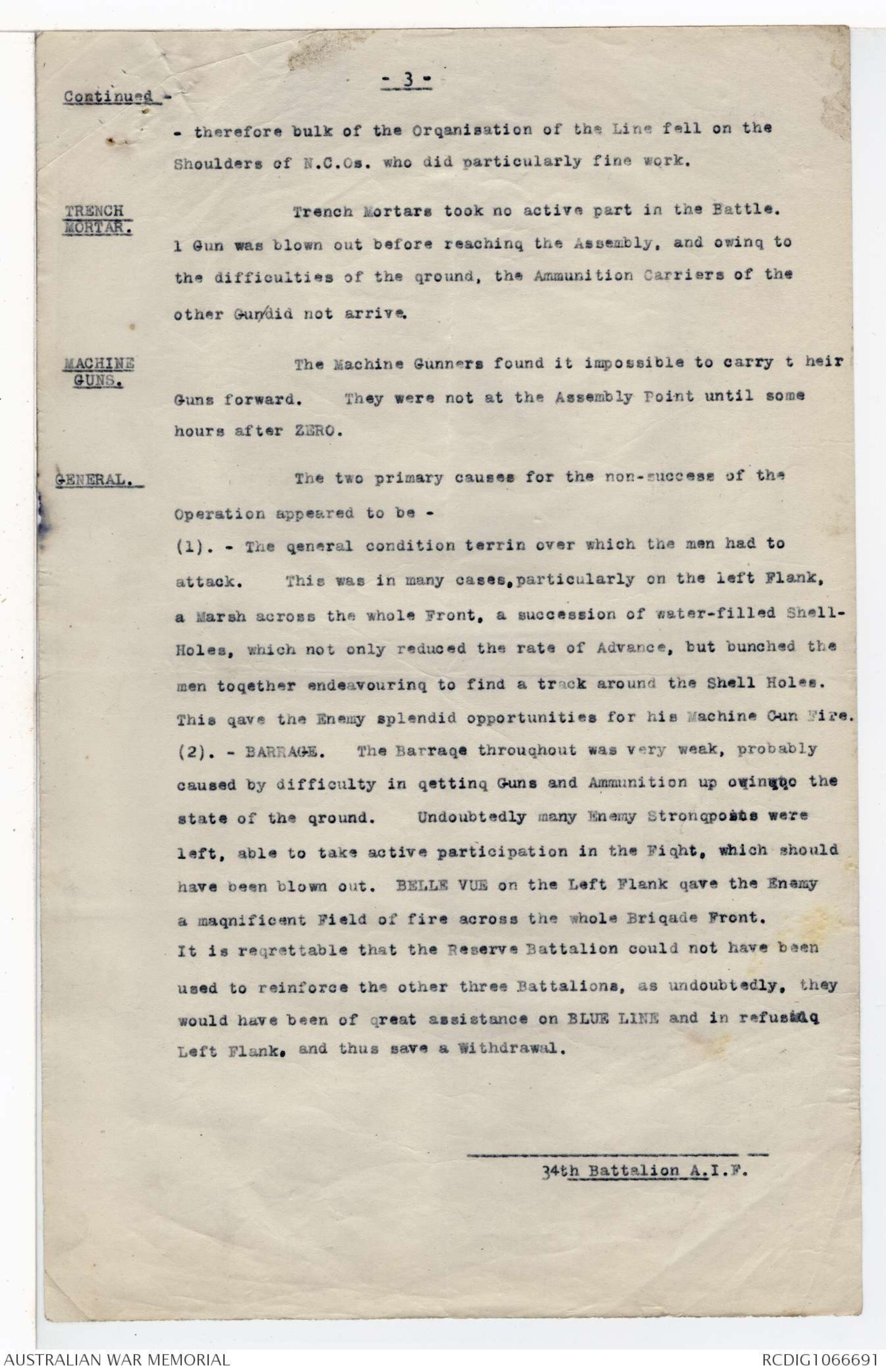
6.
12. TRANSPORT. The Regimental Transport had a most arduous and
dangerous task during the whole period.
On October 12th the pack transport comprising 21
animals left CAVALRY FARM at 1 p.m. Heavy shelling
was experienced at CAMBRIDGE ROAD and ZONNEBEKE
RAILWAY STATION. At the STATION there was considerable
congestion owing to meeting with stretcher bearers.
The track was very narrow and rough and stretchers had
to be placed off the track to allow the convoy to pass.
ALMA was reached at 4.40 p.m. It was impossible to
proceed further as several mules were bogged and rations
were dumped there. One mule could not be extricated
and had to be destroyed. The route was continuously
under shell fire.
On October 13th and 14th the same difficulties were
experienced and as the ammunition convoy was on the
track at the time, the congestion was even greater than
on zero day. On the 14th rations were delivered near
SEINE 700 yards from the Front Line.
The shelling was so heavy on the 15th that another
route via WINDMILL CAB. and SPRINGFIELD was taken.
This was over most difficult country. While at
SPRINGFIELD the convoy was attacked by enemy aircraft,
and men and animals took cover in shell holes.
Rations were delivered at 5.15 p.m.
On October 16th, the enemy so heavily shelled CAVALRY
FARM that the site was vacated and the camp established
in YPRES SOUTH at H.16.c.30.80. Two limbers were
damaged by this shelling.
Packs, blankets and tents were transported by limbers
during the day from CAVALRY FARM to YPRES SOUTH. Great
difficulty was experienced in drawing the field kitchens,
water carts and limbers through the mud on to the main
road.
Rations were brought forward from CAVALRY FARM as usual.
October 17th. During the day the Quartermaster's
Stores and remainder of the Battalion equipment was
transferred from CAVALRY FARM to YPRES SOUTH and required
all available drivers and animals.
The Battalion was to have been relieved on the night of
October 17th/18th but this was cancelled. The Transport
had late word of this and the rations did not reach SEINE
until 7.20 p.m.
October 18th. While at CAVALRY FARM removing mobilisation
stores to YPRES SOUTH enemy aeroplanes bombed the
site. One animal was wounded and a limber damaged.
13. CASUALTIES. Excluding "B" Teams the strength of the Battalion taking
part in the operations was 20 Officers, 515 other ranks.
Our total casualties for the whole period were 13 Officers
and 303 other ranks.
Officers. Other ranks.
Killed in Action. 6 40.
Died of Wounds. 2 14.
Wounded. 4 195.
Shell Shock. 1 3.
Sick (Chiefly Trench feet). - 38.
Missing. - 13.
______________________
13. 303.
14. MEDICAL. The Regimental Aid Post was established in a block house
on the railway at D.22.b.6.2. near THAMES on the night of
October 11th/12th. Touch with the 9th Field Ambulance
was maintained for the whole time.
During zero day all stretcher cases were evacuated from
the R.A.P. with very little delay. At night, owing to
the darkness and the almost impassable condition of the
track, very few cases reached the R.A.P.
Only very urgent cases were evacuated from the R.A.P.
at night the remainder being kept there until daylight.
(over)
7
On October 13th many cases were evacuated, the majority
of which were wounded on zero day. Casualties were
comparatively light on the succeeding days.
The gallant work of the stretcher bearers cannot be too
highly commended. Although exhausted by the heavy and
arduous work over such boggy and rough country, and
although under heavy and machine gun fire, they never
flinched. In places it took 6 men to carry a stretcher
case. The evacuation was consequently slow, but the
best was done under the circumstances.
15. REMARKS. Many lessons are to be learnt from these operations:-
(i) PREPARATION AND ORGANISATION.
A unit must be in a constant state of preparedness and
must always be thoroughly organised, ready to move forward
to an attack at a moment's notice.
(ii) PROMULGATION OF ORDERS AND PLANS.
These operations were rushed and all orders were given
verbally. Instructions given at a conference were taken
down in writing. Company Commanders must soe that their
subordinates also take down the instructions in writing.
Officers must know the plans so that in the event of their
seniors becoming casualties they can carry on confidently
effectively. Emphasis is yet again laid on the fact
that all ranks must know exactly what to do. When in
reserve the role of all assaulting Battalions must be
thoroughly understood and appreciated by every one.
(iii) REST BEFORE APPROACH MARCH.
On the night of October 10th/11th the Battalion bivouacked
in an open field. Officers and men spent an uncomfortable
night in the mud and rain. It is highly desirable and
very necessary that all ranks should get the maximum
amount of rest and comfort on the night preceding zero
night.
(iv) APPROACH MARCH.
Too much importance cannot be attributed to the Approach
March. The route should be as well defined and direct
as possible, and any time and labour on this is very well
spent. It should be clearly and distinctly marked and
properly policed. Every turning should be picqueted.
There should be IN and OUT routes and all traffic should be
rigorously controlled. Transport should be kept on their
own tracks. Such a prominent and known object as a
railway line and embankment should be avoided.
It is absolutely imperative that all officers and senior
N.C.O's reconnoitre the route and assembly position
beforehand.
The bad state of the track and the congestion made the
marching very difficult and fatiguing. It would be better
to move close up in support and have a much shorter
approach march. It is essential that men are as fresh as
possible on moving to the assault.
Further training in marching across open and rough
country on dark nights is needed.
(v) DEPTH OF OBJECTIVES.
In unfavourable weather and when the ground is heavy the
depth of of the objectives should be accordingly lessened.
As it is, troops taking the final objective are thoroughly
exhausted before reaching it.
(vi) TRENCH MORTARS AND MACHINE GUNS.
Trench Mortars and Machine Guns, with the necessary
ammunition, should be forwarded as close to the assembly
position as possible before zero day. The load is much
too great for men during the Approach March.
(vii) BATTALION HEADQUARTERS.
Not more than two Battalions should share the one block
house. The overcrowding greatly hampers work, and the
number of men about, and the movement attract the
attention of hostile aircraft.
8.
(viii) DIRECTION.
Evidence was shown of officers not being able to
correctly read their maps. In moving forward each
Company must have platoon guides to march on given points
and compass bearings.
Officers and non-commissioned-officers need very
thorough training in map-reading and in the use of the
compass.
(ix) GRENADES.
Each man carried one bomb, but very few were used.
The rifle and bayonet are by far the most effective
weapon. Much less time should be given to training
in bomb throwing. The rifle grenade however is much
more useful. The No.27 Grenade is of value in masking
an assault on a stronger point.
(x) WITHDRAWAL.
If the situation is such that a withdrawal is absolutely
necessary the officer on the spot who come to this
conclusion must give very clear and definite orders.
The line to which the troops are to withdraw must be
reconnoitred and made known. Sufficient officers,
N.C.O's and men must first be posted on this line and
then the troops should be withdrawn systematically,
gradually, quietly and orderly. Rigid steps must be
taken to prevent any rush or panic. Only after the
gravest consideration should such a step be taken.
If it is at all possible word should be sent to higher
authority, but in the event of a responsible officer
deeming the situation so urgent as to act at once on
his own initiative, he must report immediately, giving
the reasons and stating the position of the new line.
[*It may be taken that
opposite was done here*]
(xi) CONSOLIDATION.
It is advisable to consolidate shell holes rather than
a continuous trench. As soon as the enemy airmen
found our line it was heavily shelled.
The disadvantages of shell hole positions are:-
(i) Communication is difficult.
To get in touch with the garrisons one has to go
overland. This means that practically everything
must wait until night.
Rations and stores are not so easily distributed.
Evacuation of the wounded is more difficult.
(ii) There is the danger of the morale of the men being
affected by not seeing their officers and senior
N.C.O's as often as they are accustomed to.
(iii) The unity of command is impaired by the men being
so scattered in small posts. This, however, can
to a great extent be overcome by having complete
sections in the one shell hole.
(iv) There is not that "sympathy of numbers" as in a
trench.
(v) Drainage is very difficult.
The advantages are:-
(i) Casualties are minimised.
(ii) The men have a feeling of greater security when not
being deliberately shelled as they would be in a
definite trench.
[*The diffce from
Pozieres*]
(iii) An irregular line of shell holes is occupied
instead of a definite trench, and if the consolidated
shell holes are well concealed the position cannot
easily be detected by hostile airmen. The enemy
has then to resort to area shoots instead of
concentrating on a known and well defined line.
N.C.O's in charge of shell hole posts become more
self reliant; it certainly is good training for them.
Appendix I deals with the method in consolidating
shell holes.
(xii) COOKING.
The conditions were such that it was impossible to cook
in the forward areas. The Battalion cooks reported
(over)
9.
to Battalion Headquarters at noon on zero day but had to
be sent back to the details camp. Only 3 small tins of
solidified spirits per platoon were available. It
is very necessary and much to be desired that the men
get hot food. When cookhouses cannot be established
then there should be a plentiful supply of "Tommy Cookers",
at least one per man; each man can then have hot tea and
can heat his army rations.
Failing this, hot meals should be prepared at the details
camp and sent forward in hot food containers. No hot
food containers were available during these operations.
(xiii) WATER.
All the water sent forward tasted strongly of petrol.
Petrol tins should be thoroughly scoured before being used
for this purpose.
(xiv) STRAGGLER POSTS.
Straggler posts should be established well forward.
(xv) BURIAL OF THE DEAD.
As soon as the position is scoured each company should
detail one N.C.O. and at least four men to bury all the
dead, including those of the enemy, in their area. This
party should collect identity discs and personal effects,
which should be forwarded to Battalion Headquarters.
If it is impossible to establish a Battalion Cemetery,
each Company should endeavour to bury its dead at the one
site. Battalion Headquarters should be informed of
the locations of this burial site and of all isolated
graves.
(xvi) SALVAGE.
Greater attention should be paid to salvaging.
When the dead have been buried, each Company should
utilise its burial party for salvage work within their
area. Dumps should first be formed in a suitable place
in rear of Company areas and the location reported to
Battalion Headquarters. Ration parties and the salvage
party should then carry the salvage to the Battalion Dump
which normally will be established near the ration dump.
Here it will be classified by the regimental pioneers.
October 24th, 1917. (Signed) L. J. Morshead, Lieut-Colonel.
Commanding 33rd Battalion,
A.I.F.
10.
33rd Battalion, A.I.F. Report on Phase V, 3rd Battle of YPRES.
APPENDIX I.
CONSOLIDATION OF SHELL HOLES.
The following method is suggested when, after gaining their
objective, the infantry take up their advanced position from which
the operations will be continued shortly afterwards.
Experience has shown that the advantage of holding a shell
hole position outweighs the disadvantages. Concealment, and
protection from the weather must govern the method adopted. The
most common practice at present is to sap forward from the shell
hole into the firmer ground and form a "T", but not only does this
fail to conceal the position, but it also makes unnecessary work
as the sap is valueless and therefore wasted effort.
Take a shell hole to be 12 feet in diameter and say 5 to 6 feet
deep. It is advisable that a section garrison the one shell hole,
and after casualties it is assumed that the strength of the section
will be 5 men. Three dugouts could be made, each to hold one man
sitting up; this would allow two men on watch. Owing to the
ground being shaken by the explosion, all sides should have a batter,
especially the end wall which should be about 1 in 3. This is not
a disadvantage, but rather makes the dug-out more comfortable as it
makes a back rest for the occupant. The dimensions suggested are;
length 3 feet 6 inches, width of top 2 feet 6 inches, width of floor
2 feet, depth 3 feet 6 inches. The earth removed in digging should
be thrown round the lip of the crater; this would give some
protection against rifle and machine gun fire, and the back burst of
shells.
To give concealment and protection from the weather each dugout
is covered by a waterproof sheets, over which loose earth is
thrown. The sheet will cover part of the entrance. The forward
end of the sheet should be raised to prevent water collecting in
the middle of it. Earth thrown forward can be used for this.
The two men on watch will have waterproof sheets.
The dimensions suggested can be modified according to the size
of the shell hole. Where the shell hole is large enough and the
ground sufficiently firm, dugouts could be made to accommodate two
men, who by being together would be warmer. This could only be
done if timber were available so that the waterproof sheets could
be used.
A pathway forming a fire step will be made 4 feet to 4 feet 6
inches below the ground level according to the depth of the shell
hole.
Drainage: As the object is to maintain concealment, slits
should not be cut to allow drainage into other shell holes. It
is better to deepen the crater.
Lewis Gun sections should garrison forward shell holes.
In the event of a couter attack the men resting will fight
from their dugouts - the waterproof sheet can easily be removed -
and the sentries from between the dugouts.
(Signed) L. J. MORSHEAD, Lieut-Colonel.
Commanding 33rd Battalion, A.I.F.
11.
A CONSOLIDATED SHELL HOLE
Diagram - see original document
FIG.I
Diagram - see original document
FIG.2
EDITION 1A PASSCHENDAELE German Trenches corrected to 27-9-17. Parts of Sheets 20 & 28.
Map - see original document
Headquarters,
34th Battalion, A.I.F.
20:10:1917.
[*D of R.
File M*]
TO -
Headquarters,
9th Aus. Inf. Bde.
A.I.F.
BATTLE NARRATIVE, 34th BATTALION A.I.F.
BATTLE OF YPRES (Phase 5).
APPROACH
MARCH. The Battalion left CALVARY FARM Camp at 6 p.m. 11th.
October. Proceeded by Assembly Road along ROULES - YPRES
Railway Line. The March was carried out without difficulty
until ZONNEBEKE STATION was reached. From here to the Assembly
Tape, the Battalion was subjected to heavy Shell-fire, principally
7.7 and 4.2 H.Es. Many places had been blown in by shelling
during the Day, and direction Tape had disappeared.
ASSEMBLY. The Assembly was completed at 2.45 a.m. During
the Assembly and right up to ZERO hour, the Battalion was subjected
to heavy fire by 7.7 and 4.2 H.Es. The greater part of this
fire seemed to come from S and S.E. of PASSLE. Casualties
were heavy, principally on the right Flank near CEMETERY. The
35th and 36th Battalions, which were in rear, were badly shot up
as they got all the long stuff which passed over the 34th Battalion
BATTLE. At 5.25 a.m. our Barrage came down. It was very
weak, and in many cases it was difficult to determine which was our
Barrage, and which was fire of the Enemy. This made it difficult
for the men to keep up with the Barrage. The greatest Obst acle
met in the Advance was the condition of the ground, particularly
on the left Flank. There were many men who were lost altogeth er
in the Bog. The pace of the Advance was slowed up owing to the
assistance it was necessary to give men who had sunk into Shell-Holes,
and could not extricate themselves without assistance.
The first organised Position met with was 2 Concrete Pill Boxes
E. of AUGUSTUS ROAD and N.E. of HEINE HOUSE. This partly held up
the Centre of the Advance until Captain Jeffries organised a
Bombing Party and succeeded in rushing and capturing the Strong-point.
Four Machine Guns were captured and 35 Prisoners.
[*& enemy*]
Continued - - 2 -
150 yards in rear of this Dug-Out was a small Trench
about 50 yards long in which were about 20 to 30 of the Enemy.
This Party accounted for as the Wave passed over. Throughout
the Advance, to the RED LINE heavy Machine Gun Fire was
encountered from the direction of BELLE VUE and MEETCHIELE on
the Left Flank, and from TIBER and TIBER COPSE on the Right
Flank, .2 Machine Guns were firing from ?Decline DEDING COPSE on the
Right Flank in the Railway Embankment. The latter Position
was mopped up as the Wave went forward. On reaching the RED
LINE the Battalion proceeded to dig in, but was greatly harassed
by the fire of Machine Guns situated on the Right Flank, about
200 yards from the Railway Embankment. Captain Jeffries again
organised a Party of 2 N.C.0s. and l0 men to capture this Post.
Unfortunately, this Officer was killed in the Operation. The
N.C.0s. carried on and succeeded in rushing the Post taking 2
Guns and 40 Prisoners. Casualties all along had been very
heavy. The 35th and 36th Battalions had suffered severely.
It was decided to send all men of the 34th Battalion to assist
in the capture of the BLUE LINE and GREEN LINE. Captain
Richardson succeeded in re-organising the Battalion and took
them forward towards the BLUE LINE, where he was killed.
TIBER COPSE caused considerable trouble. They were taken by
organised Parties of the 35th and 36th Battalions augmented by
the 34th Battalion. On reaching the BLUE LINE, the Parties
commenced to dig in and were subjected the whole time to heavy
Machine Gun fire from BELLE VUE and MEETCHIELE in addition to
Barrage fire from the Enemy's Artillery. At 3 p.m. word was
received that owing to severity of Hostile Machine Gun and
Artillery Fire, the line was withdrawing. Instructions were
immediately sent to hold the Line at all costs, and to endeavour
to refuse the Left Flank. Eventually ahNew Line was constructed
from DELVE CROSSING on YPRES-ROULERS Railway N. to the direction
of WATERFIELDS. In the Advance to the RED LINE all Officers
of this Battalion had been Killed or Wounded with the exception
of three who were made Casualties before reaching the BLUE LINE.
Continued - - 3 -
- therefore bulk of the Organisation of the Line fell on the
Shoulders of N.C.Os. who did particularly fine work.
TRENCH
MORTAR. Trench Mortars took no active part in the Battle.
1 Gun was blown out before reaching the Assembly, and owing to
the difficulties of the ground, the Ammunition Carriers of the
other Gun/did not arrive.
MACHINE
GUNS. The Machine Gunners found it impossible to carry t heir
Guns forward. They were not at the Assembly Point until some
hours after ZERO.
GENERAL. The two primary causes for the non-success of the
Operation appeared to be -
(1). - The general condition terrin over which the men had to
attack. This was in many cases, particularly on the left flank,
a Marsh across the whole Front, a succession of water-filled Shell-Holes,
which not only reduced the rate of Advance, but bunched the
men together endeavouring to find a track around the Shell Holes.
This gave the Enemy splendid opportunities for his Machine Gun Fire.
(2). - BARRAGE. The Barrage throughout was very weak, probably
caused by difficulty in getting Guns and Ammunition up owinqto the
state of the ground. Undoubtedly man Enemy stronqposts were
left, able to take active participation in the Fight, which should
have been blown out. BELLE VUE on the Left Flank gave the Enemy
a magnificent Field of fire across the whole Brigade Front.
It is regrettable that the Reserve Battalion could not have been
used to reinforce the other three Battalions, as undoubtedly, they
would have been of great assistance on BLUE LINE and in refusing
Left Flank, and thus save a withdrawal.
34th Battalion A.I.F.
 Deb Parkinson
Deb ParkinsonThis transcription item is now locked to you for editing. To release the lock either Save your changes or Cancel.
This lock will be automatically released after 60 minutes of inactivity.